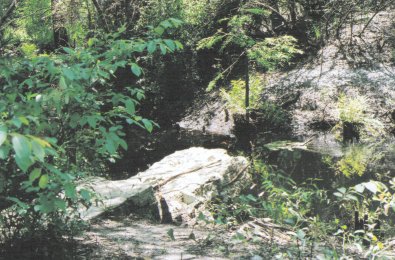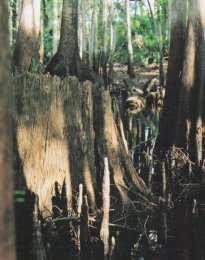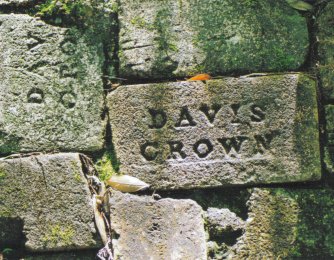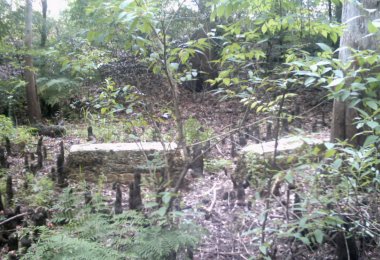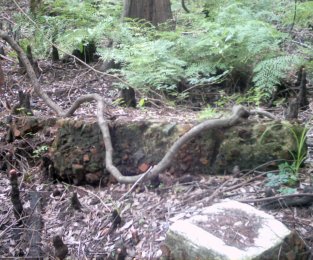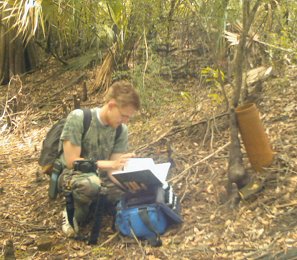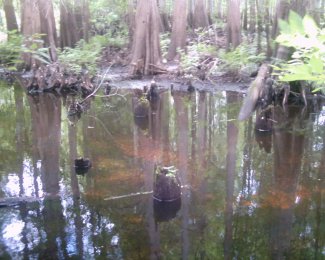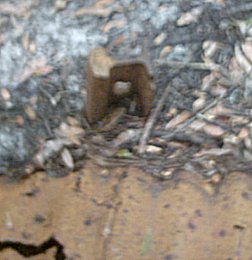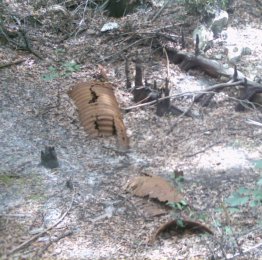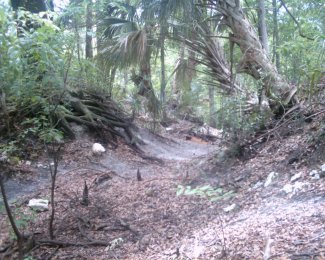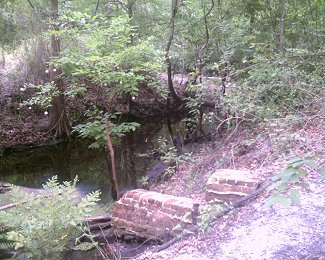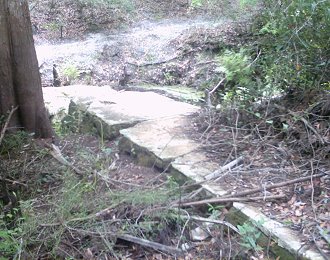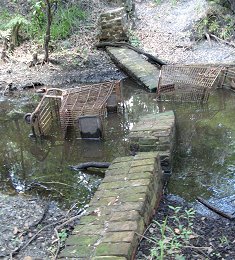HISTORY OF PASCO COUNTYFivay This page was last revised on July 21, 2019.
According to MacManus, “At its peak in 1910 Fivay was probably the largest sawmill operation in Florida. At that time, the town had a population of 1,500. Employees worked round-the-clock in day and night shifts to keep the boilers operating continuously.” Walter I. McNatt recalls: “In the early 1900s, five men whose last name started with an ‘A’ settled in the Griffin Park vicinity. They built a big saw mill and a railroad where Fivay Junction is now. Named Tucker at the time, the junction took its name from the five men. The town had a population of about 2,300 including children and was less than a square mile in size. When the supply of lumber was exhausted in 1914, the mill was closed, and the railroad track removed.” The names of the five men for whom the town was named are here. A newspaper article datelined May 30, 1901, reported, “John J. McDonough, of [Savannah, Ga.], has just concluded a deal by which he secures 175,000 acres of heavily wooded timber lands in Hernando and Pasco counties, Florida. The price paid is in the neighborhood of $500,000. The land is said to be among the best wooded in the state, and will cut not less than two billion feet of lumber. Mr. McDonough does not propose to manufacture this timber into lumber himself, but will sublease timber privileges to sawmills. Ten mills will probably be put into operation in the tract shortly. The land covers approximately twenty by twenty-four miles.” Aripeka Saw Mills was incorporated under the laws of Georgia on Sept. 17, 1903. On Sept. 19, 1903, the Atlanta Constitution reported, “Judge J. H. Lumpkin granted a charter to the Aripeka saw mills in the superior court yesterday. The petitioners for the charter were H. M. Atkinson, John J. McDonough, Martin F. Amorous and P. S. Arkwright. The concern is capitalized at $500,000, and under the charter granted has the privilege of increasing this to an amount not exceeding $3,000,000. The chief office of the company will be located in Atlanta. W. B. Stovall is attorney for the concern.” The Fivay post office was established on Sept. 23, 1904. The first postmaster was Mrs. Alice Gregg. Subsequent postmasters were Sallie M. Perkins, Oct. 2, 1907; and Daisy V. Gower, July 11, 1911. An article in the Atlanta Constitution on July 7, 1905, reported: “Macon, Ga., July 6 — (Special) — Sidney J. and Bartow Stubbs are the purchasers of large interests in the Aripeka Lumber Company at Fivay, Fla. The purchase was made through a deal closed with Atlanta attorneys and over half a million dollars is invested by the new purchasers. They will take charge of the new business on August 1. Both men are well-known Macon capitalists and are also experienced in the lumber business.” On Aug. 10, 1905, the Tampa Weekly Tribune reported, “F. B. Stubbs and S. J. Stubbs, of Macon, Ga., with their associates, C. E. McRae and P. J. Curry, have purchased the controlling interest in the Aripeka mills at Fivay, on the B. & H. railroad. They are men of vast experience in the milling interest.” On Apr. 15, 1907, the Ocala Evening Star reported: “The big mill at Fivay, Hernando county, 30 miles west of Brooksville, was destroyed by fire Friday night. Loss $90,000; insurance $37,000. Besides the saw mill the planing mil, and dry kiln went up in smoke.” On July 2, 1907, the Ocala Evening Star reported:
In 1907 Fivay had a population of 1500, according to a 1937 newspaper article. A 1907 publication lists:
On July 25, 1908, the Ocala Evening Star reported, “As is generally known, the stockholders of the Tampa Northern own the large mills at Fivay. These mills are cutting quantities of lumber now and are storing it against future demands, and it will be shipped to the east and to other sections through this port.” On Sept. 30, 1908, a meeting was held at the office of the Aripeka Saw Mills Co. for the incorporation of the town of Fivay. The following officials were selected: Mayor, W. H. Hope; Council members: Ernest Christian, Ed S. Haines, J. T. Donaldson, C. A. Blatchford, M. E. Sperry, T. A. Hughes, T. H. Martin. Town Marshall: Robert Nix. Treasurer: L. E. Thornton. Assessor: T. J. Pearce. Collector: J. F. Gardner, M. D. Clerk: C. G. Puleston. Hope was sworn in as Mayor on Oct. 2; the others were sworn in the following day. The election was overseen by J. S. Calow, J. H. Smith, and A. A. McCullom. The eligible voters were: T. H. Martin, T. J. Pearce, L. E. Thornton, E. C. Baughman, C. H. Cook, W. C. James, W. C. Wills, J. T. Donaldson, W. P. Taylor, W. G. Perkins, A. A. McCallum, C. A. Blatchfort, W. H. Hope, T. A. Hughes, C. Deason, J. B. Kennedy, C. E. Marsh, J. L. Waite, H. S. Harman, J. T. Gardner M. D., J. S. Spaws, Irb Sessions, T. H. Hovard, A. B. Porter, D. B. Whittle, M. L. Wingate, W. C. Ray, W. A. Walden, John L. McCreery, J. B. Perry, Ernest Christian. The town was centered at what is now the intersection of Little Road and S. R. 52. It consisted of these quarters of sections in T25, R16E: SE 1/4 of S2, SW 1/4 of S1, NE 1/4 of S11, NW 1/4 of S12. Mayor W. H. Hope was presumably William H. Hope, who was 24 years old in the 1910 census. Information in this paragraph was provided by Jeff Cannon. On Nov. 6, 1908, the Ocala Banner reported:
On May 28, 1909, a newspaper reported that Dayton had introduced a bill to abolish the municipality of Fivay. On July 19, 1909, the Ocala Evening Star reported, “Miss Emma Washburn, a graduate nurse from the Marion County Hospital, left this afternoon to take charge of a new hospital established by the Fivay Lumber Co., at Fivay, Fla. Dr. A. C. Coogler is physician in charge.” On Sept. 22, 1909, the Ocala Evening Star mentioned a Dr. A. Z. Cooper of Fivay. A 1910 newspaper mentioned Dr. Bryan, “a well known physician, of Fivay.” A July 21, 1909, newspaper article referred to E. J. Caraway as the Mayor-Elect of Fivay, but also referred to Mayor Caraway. On Sept. 3, 1909, the Ocala Banner reported, “Aripeka Sawmills, Fivay, Fla., T. H. Martin, manager, will build two additional mills at a cost of $250,000 each; now operates two double band mills with daily capacity of 150,000 feet of timber; planing mill with daily capacity of 75,000 feet, etc; steam power plant, electric lighting, etc.” On Sept. 10, 1909, the St. Lucie County Tribune reported, “The Aripeka Sawmills, at Fivay, of which T. H. Martin is manager, are soon to build two additional mills at a cost of $250,000 each.” On Oct. 28, 1909, the Atlanta Constitution reported, “Martin F. Amorous, well known lumberman and capitalist and member of council from the sixth ward, will soon leave Atlanta to make his home in Fivay, Fla., where he will take charge of the sawmills of the Aripeka Company. Mr. Amorous has acquired large interests in the mills. Recently he resigned from council to take effect January 1.” On Nov. 26, 1909, the Fort Pierce News reported, “The Aripeka sawmills, located at Fivay, in Pasco county, have been purchased by Martin Amorous, of Atlanta, the entire property being valued at five million dollars.” On Dec. 3, 1909, the Ocala Banner reported, “Miss Emma Washburn has returned home from Fivay, where she had had charge of the hospital, it having closed last week.” The 1909-10 University of Florida catalog indicates that R. J. Evans, class of 1906, is a physician at Fivay. On May 6, 1910, Aripeka Sawmills at Fivay owned the first registered car in western Pasco County, a White Touring Car. [Research by Jeff Cannon] According to a website describing Florida ghost towns, “Along with the sawmill there was a railroad junction constructed. Between 1910 and 1914 there were about 2,300 citizens of the town of Fivay living in less that a square mile in area.” An advertisement in the Atlanta Constitution on March 4, 1911, reads:
A. S. Gower said that in 1912 the mills closed down for good, the machinery was junked, and the timber rights were sold to the Gulf Pine Company, which established a mill at Odessa. An advertisement in the Oct. 20, 1911, Tampa Morning Tribune offered 20 mules for sale. “On account of closing out the affairs of the Aripeka Saw Mill, these mules must be sold at once.” The Feb. 1912 issue of the Florida East Coast Homeseeker reported:
The town of Fivay was offered for sale by Aripeka Sawmills in an ad in the Tampa Daily Times on Mar. 2, 1912. The Fivay post office was discontinued on June 15, 1912. On Jan. 6, 1913, a newspaper reported that a 30-room boarding house at Fivay would be razed and shipped to Tarpon Springs, where it would be rebuilt and modernized as a hotel at Tarpon Avenue and Grosse St. In April 1913 a jury failed to reach a verdict in the case of W. A. Gower, superintendent of a sawmill, who was charged with the murder of Alby Westbrooks on March 9. The Fivay Improvement Co. was formed on Jan. 12, 1915, with officers William Sonntag of Evansville, Indiana, president; John H. Twaddel of Fivay, vice president; Martin L. Waggoner of Evansville, secretary-treasurer. A 1915 report by the Florida Office of Secretary of State lists: “Fivay Improvement Company. Principal place of business, Fivay, Fla. Capital stock, $100,000.00. Filed January 12, 1915.” On Jan. 29, 1915, the Kissimmee Valley Gazette reported, “Fivay.—Fivay Improvement company, W. L. Sontag, president, will erect clubhouse.” On July 12, 1915, the Tampa Times reported:
In a later newspaper article, Mrs. Irma Twaddell Ayres recalled that she lived in Fivay for about a year. Her father John H. Twaddell, who bought the 640 acres of land there, with its 139 buildings, had dreams of building a community. She recalled, “It was sort of a ghost town, with vacant buildings in those days. … Things didn’t work out. We left. I remember my father left the hotel in care of a man named Gorden Carraway. It was wild country. I remember swimming in the Gulf the day I was 21 years old.” An application for a post office, Fivay City, in 1915, was rescinded but showed Erma Twaddell as the postmaster. The New Port Richey Press of Apr. 3, 1925, called Fivay “a mill town of 2,500 population a quarter century or so ago.” In a 1937 newspaper article, A. S. Gower said the failure of this huge enterprise was because the timber was neither as plentiful nor as large as expected, and the proceeds failed to justify the expensive machinery and large overhead. He said that when the mills closed for good, the machinery was junked and the timber rights were sold to the Gulf Pine Co., which established a mill at Odessa. Many of the houses were sold to a Finnish colony established at New Port Richey at about that time and were moved there. Other houses were torn down and moved to Tampa or Clearwater. The 1911-1912 R. L. Polk & Co.’s Florida Gazetteer and Business Directory has:
The 1918-1919 Florida State Gazetteer and Business Directory calls Fivay a discontinued post office. It reports a population of 250. On Oct. 1, 1920, the Bradford County Telegraph reported:
The following is taken from Tales of West Pasco, by Ralph Bellwood:
On Oct. 6, 1926, the Tampa Morning Tribune reported, “Fivay in the western section of Pasco county, once the site of one of the largest lumber mills in the south, but for years a deserted village, is coming back as a poultry raising section. Victor Sloan, a newcomer there, is engaged in building up a farm for raising chickens that bids fair to be one of the best in this county. Mr. Sloan has completed the building of his home and is erecting the first of his poultry houses. He expects to receive his first shipment of chicks in the next few days.” A 1929 newspaper article has: “They put up a big saw mill, dry kiln, planing mill and everything necessary to produce first class lumber. There were hotels, a club house, houses for workers, electric light plant, water works system, a railway, and whatever was necessary for the comfort and enjoyment of the five New England capitalists and their friends.” According to Ralph Bellwood, a small brick hospital was built at Fivay. The bricks from the hospital were used in 1919 to construct the Land Office (Milbauer) Building, the first brick building in New Port Richey. According to the Fivay historic marker, three hotels and a bank served the town. A booklet from about 1916 is described as showing a photo of the Fivay Bank. A 1911-12 publication described Brooksville as the nearest banking center. A map showing the approximate location of the sawmill is here. On Sept. 15, 2009, the Pasco County school board voted to name the new high school under construction at State Road 52 and Chicago Avenue “Fivay High School.” 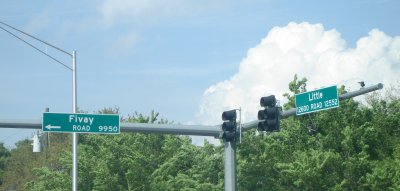
The Founders of Fivay By JEFF CANNON For nearly 20-years of researching Pasco County history, I’ve never known anyone who was able to put faces to the names of the five men who founded the little City of Fivay (5-A) in western Pasco County. Earlier this week, Jeff Miller (WPHS) and I were able to finally find the long elusive photos of these men—The Founders of Fivay (5-A)—the town where the Aripeka Lumber Company was developed and operated for nearly a decade. So, who were the men who created the town of Fivay (5-A), the town named for initials of their last names? In this post we give a summary and background of the 5-A’s and how their many business interests in Georgia lead to the development of their little west Pasco town. Martin Ford Amorous:
Preston Stanley Arkwright:
Henry “Harry” Morrell Atkinson:
Gordon Abbott:
Charles Fanning Ayer:
Old Fivay CemeteryA 1940-41 WPA survey of veterans’ graves lists among the cemeteries “Old 5-A Cemetery” in section 12, township 25, range 16. (Apparently the actual location is section 01, using these directions.) The directions to the cemetery given are: “From Railroad crossing on Main Street in the town of New Port Richey, proceed north on State Road # 19 for 6 and 3/10 miles to the intersection of said State Road #19 with State Road # 210; then east on the latter road for 2 miles, then north 1/10 mile, then east along Woods Road 3/10 mile, then walk northwest through woods for approximately 100 yards, (through brush and weeds, no road) cemetery lies ahead and obscured by undergrowth.” The survey showed no burials of veterans at the cemetery. A study in 2006 suggested the cemetery was located either in the back yard of the Hope Evangelical Lutheran Church of Bayonet Point or a little farther south. The location was also described as probably northwest of the junction of Canton Avenue and Cricket Street. (Note: a different cemetery at Fivay Junction, near the intersection of State Road 52 and U. S. 41, still exists. It is known as the Fivay-Greenfield-Tucker Cemetery.) Here’s Ready-Made Town for Sale at a BargainHas Electric Lights, Water Works, Hotels, Etc.Aripeka Sawmills Will Sell Town of Fivay—Great Opening for Good Colony SchemeThis article appeared in the Tampa Daily Times on March 2, 1912. Town for sale! Fully equipped with hand made electric lights, waterworks, 104 houses, hotels, stores, all you want in any “regular” town. That’s the proposition Auditor J. W. Broaddus of the Aripeka Saw Mills is making the public. “It’s rather unusual to be offering a town for sale,” said he yesterday, “but it’s the proposition we are making. The town is Fivay, located in Pasco county, about thirty miles from Tampa and but four miles from the Gulf of Mexico, with which it is connected with a good hard road. “It is not a ‘down-at-the-heel’ sort of town either, for the company has kept it up in good shape. The houses are all in fair condition, some of them in extremely good shape, and many pleasant little bungalow houses are in the lot. There is a building suitable for a hotel or big clubhouse if some association of sportsmen should buy the place. It has an electric light plant and a waterworks plant big enough for a town of 2,000 people, and altogether would start out as a small city with the very best of auspices.” The Aripeka people own something like 200,000 acres of land north of Tampa in Hillsborough and Pasco counties. They are about to give up the extensive lumber operations they have carried on on their own account and will lease the balance of their lumber lands to other concerns. Much of it they are selling off direct. The town of Fivay is one of the properties of which they wish to dispose. It would form a fine nucleus for colony and people who are interested in the formation of colony schemes are advertised to write to Mr. Broaddus. Much of the land is well adapted to agriculture and there are a few farms on it at present, though little in the way of agricultural development has been done. It is diversified, rolling country, and bids fair to develop largely in time. Mitchell to Saw Logs in Fivay Mill Pond (1920)Revives Memories of Once Golden Days of the Deserted VillageThe following article appeared in the Dade City Banner on Sept. 10, 1920. Many who have come to Pasco county in recent years do not know that within three miles of the Gulf of Mexico and a mile or two farther south than Dade City, was the most promising town in Pasco county some ten to fifteen years ago. It was Fivay, an aristocrat among lumber camps. The company had some rather large ideas. For instance they built the mill of brick and connected it with the Tampa & Northern railway at Tucker, nine miles east with a railroad and built railroad shops to care for the rolling stock where as many as fifty men were employed. There was a large hotel, a commissary, a hundred good residences and other buildings that go to make up a town. The main street was planked. The social life was cared for by a fine club house, tennis court, golf links and a park, and it is said that guests came from as far as Jacksonville for week-end affairs. Today there are a lot of decaying buildings under the charge of a solitary care taker. The company went broke about ten years ago. All of which is intended as an introduction to the statement that J. M. Mitchell, the county commissioner, is in a deal to buy the logs in the log pond at Fivay, and saw them into lumber at his mill. It is estimated that there are between 500,000 and 1,000,000 feet of timer in the pond, a large portion of which is cypress, and it is supposed that the cypress at least is in good milling condition. Mr. Mitchell has a saw mill at Elfers and he has not decided yet whether to haul the logs to Elfers or the mill to the log pond. The Story of Fivay (1922)This an excerpt of an article about Hudson by C. B. Taylor in the Dade City Banner of Dec. 8, 1922. Returning to Hudson and traversing the first hard road ever built in Pasco county (and right now one of the best), one comes to the site of the once famous town of Fivay. From stories I have been told the history of this place must, if written out, read like a romance; and some day I hope to be able to collect them all and write the story. Briefly however, the story is: Five multimillionaires organized a company to cut the timber which grew in this section of the country. All of their names began with the letter A so the town founded on the site chosen for their mill was called Five A’s which was later corrupted into Fivay. Never Mind the Cost The superintendent appointed by them was instructed to build the finest mill in the south, with surroundings to match and “never mind the cost.” Well and faithfully he labored in the wilderness. The mill was a wonder of completeness and surrounding it were office buildings, store houses, hotels, dwellings, and on the top of a bluff overlooking the entire town a club house that was famous throughout the state. It is said that when the town was abolished, a carload of empty whiskey and wine bottles were shipped away, and for years after, farmers came there for bottles to put their syrup in, and bootleggers to put their moonshine in. When the work was all completed, the superintendent made a report that he had expended over two million dollars in the work. The report closed with the comment, “I have followed your instruction and built the mill and the town. If you can operate it at a profit, you can do more than I can.” A Wide Open Town The mill started and Fivay had a population of two thousand people. It was a wide open town and life was much like that in the mining camps of the west. I have seen the records of the first sessions of the Mayor’s court held there and the first six cases are all for fighting. the defendants in every case were fined from one to five dollars. As predicted the mill could not be operated at a profit and orders were issued to dismantle it. This was done and the town abandoned. The houses were sold for scrap and now the only sign of those halcyon days is the old brick dry kiln and the ruins of a few sheds and other buildings. Notable Guests at Liberty Lodge But Fivay is coming back and will soon reappear on the map. The principal inhabitant at present is J. D. Middy, who has made his home there. Mr. Middy has considerable acreage which he is holding until the hard road from Dade City to the coast is built. His home, which is known as “Liberty Lodge,” is visited almost daily by people of more or less consequence. On the Sunday before I called on him, there were only twenty guests for dinner. Among others of the distinction who have called at Liberty Lodge was Robert Chambers, the author, and John Galsworthy, the English writer. The latter Mr. Middy failed to recognize until after he left, when he picked up a magazine, with his picture in it, telling that he was “in Florida studying the native in his habitat.” Mr. Middy says that there are a number of people who are planning to settle in Fivay but he his holding most of them off till later, as he thinks the time is not yet ripe for them to come. He is expecting two or three families this winter. Sawmill Town Went From Boom to Bust (1988)This article appeared in the Tampa Tribune on Feb. 28, 1988. By LELAND HAWES From the turn of the century past World War II, sawmills ripped and whined through much of Florida’s virgin timber land, crating brief boom towns that eventually turned to ghost towns. One such mini-city sprang up in the woods of western Pasco County, yet its name survives today only in a road designation. Recently John D. Weekley of Tampa, a retired third-generation lumber man, said he had just learned of the existence of Fivay and he wanted to know more. In a response to an inquiry on this page, Ralph A. Gower of Temple Terrace came forth with background possible only because he’s the son of the one-time superintendent of the sawmill at Fivay—and because he lived there as a boy. Fivay existed as a town for less than a decade, and it started out being known as Five A’s. Its designation came from the owners of the sawmill, whose names all started with “A.” Ralph Amorous Gower gained a middle name from one of the owners—Martin F. Amorous, a prominent Atlanta businessman, who took an active role on the local scene. Amorous and his four associates had been allied in another enterprise, the Atlanta Street Railway and Electric Co., which later became Georgia Power Co. Gower’s father, William Arthur Gower, went to work for Amorous at the age of 13 and had to engage in a fistfight to beat out another applicant for a job as office boy. “I don’t know if Mr. Amorous was aware of the circumstances,” Ralph Gower said, “but the relationship between employer and employee that eventful day lasted a lifetime.” W. A. Gower worked in Amorous’ various lumber operations, and his family lived in Georgia sawmill towns such as Cordele, Moultrie, Tifton, Ty Ty, Sunset and Crossland. “Some of my earliest memories are the sweet smell of fresh sawdust and live steam—and the whine of racing saws,” Ralph Gower said. “We customarily lived in company housing, and only on rare occasions did we enjoy electric lights, running water and inside plumbing.” In 1905, when Ralph Gower was only 2 years old, the family came to Florida after the Atlanta men bought some 280,000 acres of wooded land in west Pasco, Hillsborough and Hernando counties. On Sept. 11, 1906, a dispute arose between Julius Franklin Higginbotham (b. Brooksville, 1867), a contractor, and Leroy Ward Hicks (b. Macon, Ga., April 6, 1871), the conductor of the train that connected Hudson and Brooksville. Both men shot each other and both died instantly. The 30-mile railroad was operated by Aripeka Saw Mills, and the shooting occurred at the Brooksville depot. Hicks was buried at Macon. Evidently a sawmill had been started at the same site in 1897 by previous owners, Sessions and Bullard, and a spur line connected it with an early short railroad line, the Brooksville and Hudson. Gower believes the earlier sawmill had burned, and the new Georgia owners started from scratch in building a huge operation that became known as Aripeka Saw Mills at the company town, Fivay. “My father told me later that everyone involved in the operation then lived in Brooksville and rode a work-train to Fivay every day,” Gower related. Because of health problems, Gower’s father and his family soon moved back to Georgia. Not until about 1910 did W. A. Gower return as superintendent of the Fivay mills. “By this time, the mills were in full operation, and the population of the town, as I recall being told, was around 1,500,” Ralph Gower said. Fivay was “bursting at the seams,” he added. “They were really hauling the logs in.” From the perspective of time, Gower views it as a wasteful operation. “After they went through a place, it looked like a tornado hit. They took only the biggest trees, and left the tops on the ground.” Crews laid tram roads into timber areas. Log carts with huge wheels would be pulled by mules once the trees were felled and logs attached by hooks. Fifteen steam locomotives hauled the loads into the mills, and there were several steam “skidders,” Gowers said, describing them as huge portable winches for snaking cypress from swamps. There were two large sawmills—one to cut pine and the other for cypress, he said. John Weekley said the Fivay operation was probably the largest in Florida in that period, based on the equipment and manpower it used. Since Fivay was a company town, it had the usual commissary, a company office and post office, a warehouse, and a “primitive” drug store and soda fountain, with a doctor’s clinic upstairs. Electricity came from a power plant fueled by sawdust and slabs. “None of the living quarters for whites or blacks had inside plumbing, although some had electric lights,” Gower said. The town had its own water system, too. “The mills were located beside a large mill pond, into which the cypress logs were dumped, to be retrieved later as needed,” Gower said, explaining that the pond was created by damming up Bear Creek. A few hundred yards downstream, Bear Creek disappeared into Bear Sink, a huge sinkhole in the side of a sand hill. “Water running into this sinkhole reappears at the very edge of the Gulf of Mexico, right in the middle of the town of Hudson four miles away,” Gower said. “This fact became known one very rainy summer when the sawdust dam at the millpond in Fivay washed out, only to boil up in Hudson.” The late Judge J. A. Hendley, who wrote a history of Pasco County, said the town at Fivay “flourished like a green bay tree for a while.” “Boilers of the plant were never cold,” he wrote. “A day and night shift kept the plant in constant operation.” Judge Hendley and Gower both mentioned one point: Fivay was a hell-raising town on Saturday nights. The woodsmen pitched wild parties with moonshine liquor on their time off. Casualties were so high in spontaneous shootings that the community cemetery filled rapidly. “They hauled bodies out there every Saturday night,” Gower said. “There were stills in all those woods.” One story had the area’s justice of the peace assessing fines with a Sears, Roebuck catalog. He’d open a page and randomly point to an item. The price would determine the fine for an offense. Gower remembers only two telephones in Fivay, hooked by a single wire to Fivay Junction on the Tampa Northern Railroad tracks some miles away. Incidentally, the railroad was founded by the Fivay owners, with Amorous as first president. Amorous’ home on a hill overlooking the mill site had one of the telephones. “There were two other large homes up the hill near the Amorous house,” Gower said. “one was occupied by the company auditor, George Broadhurst, the other was a large boarding house.” The Fivay venture was never successful, Gower said. “There just was not enough timber on the land to support so large an investment, and the mills ‘cut out’ much sooner than anticipated.” He believes production ended about 1912. “The company liquidated what it could, and Fivay became a ghost town.” Gower’s father, superintendent at the time, had the job of selling off the custom-made machinery for scrap. Junk dealers hauled away most of it. Gower’s mother filled in as Fivay’s last postmaster, after the mills shut down. The family home was torn down, every board marked, and it was rebuilt in Tampa’s Ballast Point. W. A. Gower bought 80 acres of the remaining land, learning that U. S. 41 was coming that way. Eventually he opened a service station on a strategic crossroad that became known as Gower’s Corners. His son is disdainful of maps that leave out the apostrophe and call it “Gowers Corner.” He points out that his father owned all four corners at one time. Ralph Gower said his father had dropped out of school after the sixth grade, but was well-informed. “He could do anything around a sawmill—splice a cable, repair a steam engine or run a saw.” After the sawmills at Fivay went out of business, W. A. Gower built a portable sawmill of his own which he could take into the woods. “He would have woodsmen cut trees, then he would make 2-by-4 boards for lumber companies or crossties for the railroads.” The older Gower kept up his contacts with Martin Amorous over the years, and Ralph Gower remembers meeting Amorous at a dinner at his parents’ home in Tampa about 1921. “Physically, he was a stocky person,” he said. “He always wore a mustache, and he was practically bald. He and my father were still good friends.” When Judge Hendley wrote his Pasco history around 1940, he said Fivay “looks like a western mining town after the gold ore had been exhausted.” Today, the one-time ghost town is part of the population growth explosion spreading eastward from U. S. 19 along State Road 52. The highway follows the railroad right-of-way which once served the logging town. Shopping centers and homes have replaced the sawmill community, with only the “Fivay Road” sign a reminder of its contrasting past. A postscript on how this story came about: John Weekley and his wife were on a cruise on the Danube River in Europe, when they met Mrs. William H. Moore, of Saratoga Springs, N. Y. When Mrs. Moore learned that Weekley had spent a lifetime in the lumber business in Tampa, she asked him if he knew anything about Fivay. Weekley had never heard of it. Mrs. Moore is Martin Amorous’ granddaughter, and she furnished some of the background on the Atlanta man who was one of the five “A’s.” Included was a handwritten letter Amorous sent to his wife with a Fivay postmark March 11, 1905. Obviously lonely, he wrote: “My darling, I am alone in the banquet room of the club house. My last visitor Mr. Sizer left me today. I ate supper alone and laid down on the sofa…. “I will leave here Sunday a.m. by buggy for Tampa, thence lave there Monday night for home.” What Remains of the Fivay SawmillThese pictures were taken by Jeff Cannon in June 2005. They may not be reproduced.
(2006 photographs by Jeff Miller)  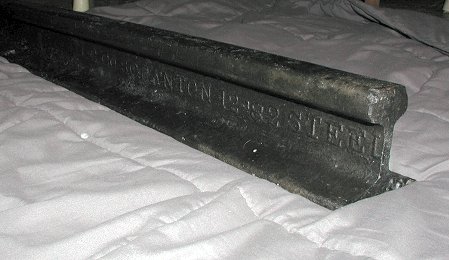 |

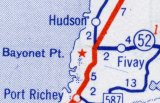 In a 1937 newspaper article, A. S. Gower recalled that
as mill superintendent he sawed the first log at Fivay in
1904 and the last one in 1912. Gower said
the saw mill equipment included four separate mills,
14 locomotives, 75 miles of tram road, 50 log cars, two
big steel loaders, big steel skidder, and 150 mules.
He said the town of Fivay had three hotels, a club house,
a 100,000 gallon 100 foot water tank with
electric lights and running water in all the houses.
One big commissary with a stock of $40,000 provided
a shopping place for the citizens.
In a 1937 newspaper article, A. S. Gower recalled that
as mill superintendent he sawed the first log at Fivay in
1904 and the last one in 1912. Gower said
the saw mill equipment included four separate mills,
14 locomotives, 75 miles of tram road, 50 log cars, two
big steel loaders, big steel skidder, and 150 mules.
He said the town of Fivay had three hotels, a club house,
a 100,000 gallon 100 foot water tank with
electric lights and running water in all the houses.
One big commissary with a stock of $40,000 provided
a shopping place for the citizens.